Unknown Facts About Pestwise
Unknown Facts About Pestwise
Blog Article
7 Simple Techniques For Pestwise
Table of ContentsThe Of PestwiseAbout PestwiseGetting The Pestwise To WorkRumored Buzz on PestwiseSome Ideas on Pestwise You Should KnowAbout PestwiseWhat Does Pestwise Do?

Q. Define "incorporated insect monitoring" (IPM) and listing numerous possible control tactics that might be used in an IPM method. A. Integrated pest monitoring is the combining of ideal insect control tactics into a solitary plan to lower insects and their damages to an acceptable level. Parasite control strategies might include: host resistance, organic control, cultural control, mechanical control, cleanliness, and chemical (pesticide) control.
Getting The Pestwise To Work
What can you do to keep the bugs you are attempting to control from ending up being immune to the chemicals you use? A. Bug resistance can be lowered by utilizing incorporated pest administration and rotating the sorts of chemicals used.
Insects are a vital risk to the farming service, and incorporated pest monitoring helps cultivators address and mitigate these risks. Integrated insect monitoring uses several approaches in complex, therefore being an extra effective service to the issue. Commercial Pest Control. In certain, eliminating hostile chemical approaches enables decreasing damage to people and the atmosphere by using natural and more secure alternatives rather
The Only Guide to Pestwise
The objective of incorporated insect management is to minimize this injury and control acceptable infestation degrees rather than get rid of all unwanted populations. This is why it is essential to recognize what procedures are warranted in each instance and use hostile ones just when other incorporated management strategies don't function. Integrated management alleviates the negative effects of a non-IPM method, and the major benefits of IPM Conveniences of IPM.
An appropriate understanding of the problem scope determines if the trouble ought to be resolved. are the next parts of an IPM program because it is necessary to realize if the organisms make potential threats and choose the incorporated management choices or the details pesticide usage. intend to lower invasions by using different agronomic methods.
Get This Report about Pestwise
Integrated monitoring options in an IPM program start with safer to much more aggressive ones. The above-mentioned incorporated monitoring facets aid recognize just how to prepare and carry out an IPM program action by action: Display your plants regularly.

Among others, IPM social approaches include the adhering to field monitoring methods: dirt treatment; option of suitable plants; crop turning; interplanting or strip chopping; choice of planting dates; weed control; usage of catch plants. Beneficial soil problems speed up plant development, and strenuous crops are much more resistant to problems. Healthy and balanced seedlings and seeds predetermine successful crop advancement, so it is vital to pick pest-free planting material with strong roots.
, which is likewise made use of in the incorporated parasite management system. On the other hand, invasions enhance when plants of the exact same plant type or household grow together.
Similarly, potato beetles can harm growing potatoes, along with tomatoes. Growing catch plants in spots is another option for IPM intercropping. This integrated pest management method recommends bring in bugs to certain plants and after that regulating them with chemical or mechanical methods. Specifically, you can grow soybeans as trap crops for Japanese beetles.
Pestwise - The Facts
Obstacles are common instances of physical IPM methods. Allow's take a closer check out them. Removing or choosing pests out manually is a time and labor-consuming alternative that is commonly used in incorporated administration and natural farming. Fully Continued grown insects or their eggs and larvae are accumulated by hand and destroyed.

Division of Plant Sciences. This integrated administration technique indicates an usual way of destroying parasites by killers, parasitoids, microorganisms, and various other organic control agents (aka antagonistic organisms). The duty of organic control in IPM is to.
The Only Guide to Pestwise
With time, their populace transformed out to be an actual nuisance to farmers alongside aboriginal kangaroos or dingoes. The walking cane toad is an additional instance illustrating integrated organic control failing in this regard when it refused to hunt the target varieties and came to be an insect itself. Parasitoids develop on or within their hosts to eventually eliminate them after developing.
Report this page